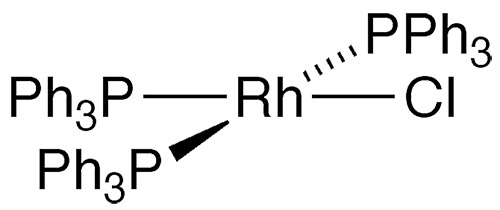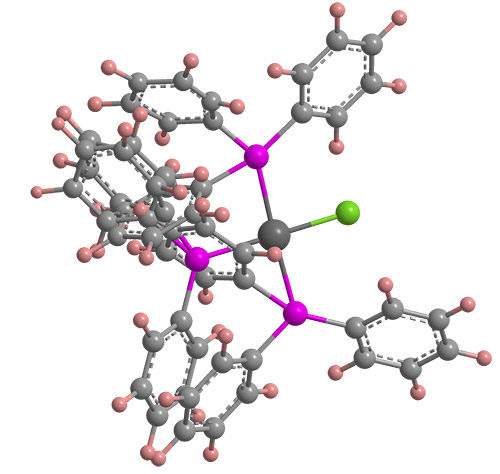What molecule am I?


Wilkinson’s catalyst, formally chloridotris(triphenylphosphine)rhodium(I) [RhCl(PPh3)3], is a coordination complex that catalyzes a wide range of organic reactions, principally the hydrogenation of alkenes and alkynes and hydrofunctionalization reactions across double bonds such as hydroacylation (hydroformylation) and hydrosilylation. It is named for Geoffrey Wilkinson, who won the 1973 Nobel Prize in Chemistry.
Wilkinson, at Imperial College London, published his first papers on rhodium catalysts in 1965. At the Robert A. Welch Foundation Conference on Chemical Research that year, he described the synthesis of the complex, in which rhodium(III) chloride1 (RhCl3) and excess triphenylphosphine2 (PPh3) are heated in ethanol solution. In a second paper, with three coauthors, he elucidated the hydride intermediates formed when RhCl(PPh3)3 catalyzes hydrogenation reactions of unsaturated compounds.
Three years later, Wilkinson, along with D. Evans and J. A. Osborn, described the use of rhodium complex catalysts, including RhCl(PPh3)3, to promote the hydroformylation of alkenes. Overall, Wilkinson and his colleagues wrote 26 papers from 1965 to 1990 on the synthesis, properties, and catalytic behavior of RhCl(PPh3)3 and related complexes.
1. CAS Reg. No. 10049-07-7.
2. CAS Reg. No. 603-35-0.
Wilkinson’s catalyst hazard information*
| Hazard class** | GHS code and hazard statement | |
|---|---|---|
| Skin corrosion/irritation, category 2 | H315—Causes skin irritation | |
| Skin sensitization, category 1 | H317—May cause an allergic skin reaction | |
Serious eye damage/eye irritation, category 2A | H319—Causes serious eye irritation | |
Specific target organ toxicity, single exposure, respiratory tract irritation, category 3 | H335—May cause respiratory irritation | |
| Long-term (chronic) aquatic hazard, category 4 | H413—May cause long-lasting harmful effects to aquatic life | |
*Compilation of multiple safety data sheets.
**Globally Harmonized System (GHS) of Classification and Labeling of Chemicals. Explanation of pictograms.
Molecule of the Future
Varespladib1 is a medication that was originally developed by Anthera Pharmaceuticals (Hayward, CA) as a treatment for inflammatory diseases such as acute coronary syndrome and acute chest syndrome. A Phase 3 clinical trial, however, showed inadequate efficacy, and Anthera halted the trial in 2012.

A few years later, varespladib gained a new lease on life. As the Los Angeles Times reported last month, for several years Matthew Lewin at the California Academy of Sciences (San Francisco) had tried to develop an oral medication to administer quickly to individuals bitten by poisonous snakes. Learning that varespladib blocks phospholipase A22, a toxic enzyme that exists in almost all snake venoms, he formulated it into a pill that reverses that stops or reverses the toxin’s effects (e.g., neurological damage and severe bleeding) if given immediately after the snakebite.
In 2021, Lewin, then at newly formed company Ophirex (Corte Madera, CA), with colleagues there and in Australia and Bangladesh reported that varespladib effectively inhibits anticoagulant activities of venoms from several species of African spitting cobra in the genus Naja.
1. CAS Reg. No. 172732-68-2.
2. CAS Reg. No. 9001-84-7.
Molecule in the News
Hydrogen cyanide1 (HCN) was the molecule of the week for December 6, 2010. It is, of course, a poisonous gas; but it has many industrial uses.
Last month, HCN was in the news for a quite different reason. Jonah S. Peter*, Tom A. Nordheim, and Kevin P. Hand at Caltech’s Jet Propulsion Laboratory (La Cañada Flintridge, CA) reported that the Cassini spacecraft observed HCN, among many other molecules, in plumes ejected from the south pole of Saturn’s moon Enceladus. The authors speculate that the presence of HCN could support microbial communities on the moon.
1. CAS Reg. No. 74-90-8.
Molecule of the Future
Once a month we bring you a newly discovered or developed molecule that has important implications for the future of chemistry or society in general. Look for it the third week of each month. Learn more about this month's Molecule of the Future below.
We're looking for more molecules of the future!
Do you have a suggestion for the next molecule of the future? Send your idea to MOTW.
Molecule in the News
MOTW highlights molecules that appear in major news outlets. See this week's edition below.
This molecule was suggested by a reader. We present almost all of the molecules suggested by our readers. If you have a molecule you would like us to consider, please send us a message. And thank you for your interest in Molecule of the Week! —Ed.
Wilkinson’s catalyst
fast facts
| CAS Reg. No. | 14694-95-2 |
| SciFinder nomenclature | Rhodium, chlorotris (triphenylphosphine)-, (SP-4-2)- |
| Empirical formula | C54H45ClP3Rh |
| Molar mass | 925.22 g/mol |
| Appearance | Reda crystals or powder |
| Melting range | 245–250 °C |
| Water solubility | Insoluble |
a. May also be red-brown or -yellow.

Learn more about this molecule from CAS, the most authoritative and comprehensive source for chemical information.
Molecule of the Week needs your suggestions!
If your favorite molecule is not in our archive, please send us a message. The molecule can be notable for its current or historical importance or for any quirky reason. Thank you!
Stay Ahead of the Chemistry Curve
Learn how ACS can help you stay ahead in the world of chemistry.

